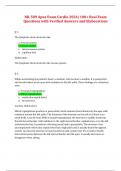NR-509 Apea Exam Cardio 2024| 100+ Real Exam
Questions with Verified Answers and Elaborations
Q 1:
The lymphatic ducts drain into the:
a. Arterial system.
b. Venous system.
c. Arteriovenous system.
d. Capillary bed.
Elaboration:
The lymphatic ducts drain into the venous system.
Q 2:
While auscultating the patient's heart, a medium, soft murmur is audible. It is pansystolic
and heard loudest at the apex with radiation to the left axilla. These findings are consistent
with:
a. Tricuspid regurgitation.
b. Mitral regurgitation.
c. ventricular septal defect
d. An innocent
murmur. Elaboration:
Mitral regurgitation produces a pansystolic, harsh murmur heard loudest at the apex with
radiation toward the left axilla. The intensity of the murmur can be soft or if there is an
atrial thrill, it can be loud. With tricuspid regurgitation, the murmur is audible loudest at
the left sternal border with radiation to the right sternal border, xiphoid area, or to the left
midclavicular line. It produces a blowing sound and is pansystolic. The murmur of an
uncomplicated ventricular septal defect has a high pitch and is usually heard throughout
systole. An innocent murmur is heard loudest at mid systole near the second to fourth
intercostal spaces between the left sternal border and the apex. It usually decreases or
disappears when sitting.
,Q 3:
Which of this group of symptoms would be suggestive of an infant experiencing a
congenital heart defect associated with a decreased pulmonary blood flow pattern?
a. Tissue perfusion greater than 3 seconds, bluish colored skin, and poor feeding
b. Abnormal heart sounds, capillary refill less than 2 seconds, and oxygen
saturation less than 95%
c. Capillary refill less than 2 seconds, tissue perfusion less than 3 seconds, and
oxygen saturation greater than 95%
d. Poor feeding, audible heart murmur, and oxygen saturation greater than
95% Elaboration:
Infants with defects resulting from decreased pulmonary blood flow have cyanosis
because of desaturated blood entering systemic circulation and/or because of the inability
to get blood to the lungs. Tetralogy of Fallot (TOF), pulmonary atresia and tricuspid atresia
all fall in this category and are considered cyanotic defects. Due to the ventricular septal
defect in TOF, the absence of the tricuspid valve or pulmonary valve in tricuspid and
pulmonary atresia, one should hear abnormal heart sounds either due to the murmur in
TOF or single heart sounds of S1 or S2 in pulmonary atresia or tricuspid atresia. Usually
these infants have activity intolerance and therefore, experience failure to thrive because
of their inability to consume enough formula to gain weight appropriately. Capillary refill
is usually prolonged due to poor oxygenation and poor perfusion secondary to the defect
as well as the O2 sats being lower than normal, sometimes even in the 80% range.
Q 4:
Right atrial pressure can be determined by:
a. Palpating the carotid pulse. Incorrect
b. Identifying the pulsations of the right jugular vein.
c. Analyzing the arterial blood gases.
d. Assessing for dependent
edema. Elaboration:
,Jugular venous pressure reflects pressure in the right atrium and is best assessed from
pulsations in the right internal jugular vein. This is an indicator of cardiac function and
right heart hemodynamics. Palpating the carotid artery denotes arterial pressure;
analyzing blood gases reflects the status of the arterial blood. Assessing for dependent
edema is a reflection of heart failure and poor venous return and not atrial pressure.
Q 5:
When assessing the heart rate of a healthy 13-month-old child, which one of thesesites is
the most appropriate for this child?
a. Apical pulse at the 5th intercostal space right midclavicular line
b. Apical pulse between the 3rd and 4th intercostal space in the left midclavicular line
c. Apical pulse to the right of the midclavicular line in the 3rd intercostal space
d. Apical pulse in the 5th intercostal space left midclavicular line Incorrect
Elaboration:
The apical pulse in a 13-month-old is auscultated for a full minute between the 3rd and 4th
intercostal space to the left of the midclavicular line. The only time one would auscultate
the right midclavicular line would be if the child had situs inversus or dextrocardia.
Q 6:
The infraorbital or maxillary, buccinator, and supramandibular lymph nodes drain
lymphatic fluid from the:
a. Palpebral conjunctiva and the skin adjacent to the ear within the temporal region.
b. Eyelids, the conjunctiva, and the skin and mucous membrane of the nose and cheek.
c. Mouth, throat, and face. Incorrect
d. Posterior part of the temporoparietal
region. Elaboration:
The facial lymph nodes (infraorbital or maxillary, buccinator, and supramandibular) drain
lymphatic fluid from the eyelids, the conjunctiva, and the skin and mucous membranes of
the nose and cheek. Tonsillar, submandibular, and submental nodes (anterior and
superficial cervical lymph nodes) drain lymphatic fluid from portions of the mouth, throat,
and face. The preauricular nodes drain lymphatic fluid from the palpebral conjunctiva as
, well as the skin adjacent to the ear within the temporal region. The posterior auricular
lymph nodes drain lymphatic fluid from the posterior part of the temporoparietal region.
Q 7:
The external iliac lymph nodes drain lymphatic fluid from the following areas except the:
a. Urinary bladder.
b. Prostate.
c. Uterus.
d. Gluteal region.
Elaboration:
The external iliac lymph nodes receive lymphatic fluid from the umbilicus, urinary
bladder, prostate or uterus, and the upper vagina. The internal iliac lymph nodes receive
lymphatic fluid from all pelvic viscera, deep part of the perineum, and the gluteal region.
Q 8:
The amplitude of the pulse in a patient in cardiogenic shock would most likely appear:
a. Bounding.
b. thread.
c. Normal.
d. As a bruit.
Elaboration:
The amplitude of the pulse correlates with pulse pressure. Small, thready, or weak pulses
occur in patients in cardiogenic shock. Bounding pulses are seen in patients in aortic
insufficiency. A bruit is not typically associated with pulse amplitude. It is associated with
stenosis or turbulent arterial blood flow. Usually the presence of a bruit requires further
investigation and is not in itself diagnostic.
Q 9:




